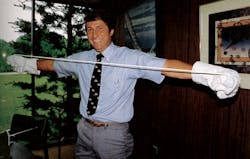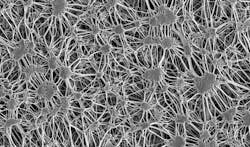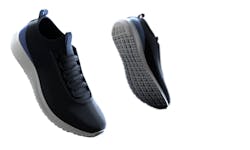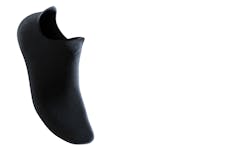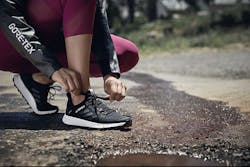In 1958, former DuPont researcher Bill Gore started up a company that would develop new ways to use polytetrafluoroethylene, or PTFE. He came up with hundreds, maybe thousands.
In 1960, the son, Bob Gore discovered how to transform PTFE into a strong, porous, adjustable membrane by expanding it into ePTFE. PTFE and ePTFE are chemically identical, but the expanded version can be made with pores of various sizes, and it is much less dense, so its mechanical properties are different.
ePTFE really became popular after W.L. Gore & Assoc. took advantage of the pores in the expanded polymer. Engineers could make them too small to let water in but large enough to let air and water vapor out, making it the first fabric that is truly breathable. But in one industry sector the breathable polymer made a big splash: athletic gear, especially shoes.
Bob Gore discovered how to expand PTFE and create an adjustable membrane that was waterproof but would let go through it, the first truly breathable fabric.
Expanding PTFE
ePTFE is among the more innovative variations in processing and using PTFE. Turing PTFE into ePTFE doesn’t require soluble fillers, foaming agents, or chemical additives—just a little mechanical manipulation and some heat treatments.
The expansion process begins with an extrusion of a paste consisting of fine PTFE powder and typical lubricants or mineral spirits. Lubricant are removed by a quick heat treatment. The lubricant-free extrusion, which can be in the shape of a rod, tube, or tape, next gets expansion.
In this process, unsintered PTFE extrusions are first heated to anywhere from 35° to 320°C while held and restrained in a device that can stretch extrusions at rates varying from 10% per second to 40,000% per second.
Material engineers such as those at Gore-Tex, are helping make lighter, more comfortable running shoes that re also waterproof but breathable.
The stretched part is then heated to above 330°C, usually to between 350°C and 370°C, while held in a device that prevents the stretched part from shrinking for anywhere from a few seconds to a few hours. After this heat treatment, called “amorphous locking,” the expanded part cools and is removed.
Higher stretching rate yields ePTFE with more uniform pores, and operators can control pore size and number, or density. Pores can range in size from 1 to 6 μm. Porosity can range from 90% to 95%. Sintered PTFE parts have densities of about 2.15 g/cm3; unsintered, unexpanded parts have densities of 1.5 g/cm3, but they can be as low as less than 0.1 g/cm3, with a porosity of 96%. Density and porosity are linearly related. If pore size is quite small, less than 1 μm, parts can have porosities of up to 90% porosity; larger size pores (1-6 μm) contribute to driving porosity above 95%.
The heat-treated ePTFE web has a higher permeability than PTFE to gases and liquids due to its many pores. It can also be a semi-permeable membrane by letting the wetting liquids through and turning away non-wetting fluids. For example, a gas-saturated membrane in contact with gas and water will let gas through and keep water out as long as the water pressure is below the water entry pressure. When porosity climbs above 9%, air permeability soars while water-entry pressure decreases to a fairly small value. There is a range where porosity can be selected to balance the air permeability and water impermeability, which is useful to applications such as clothing and shoes.
Under a microscope, the many pores in it are easy to see. Engineers can tailor the size of the pores, while ePTFE is made so they are too small to let water molecules in, but large enough to air molecules pass through.
Keeping Feet Dry
Bob Gore used ePTFE to make fabrics and fabric assemblies for companies that make athletic shoes and clothing. For shoes, ePTFE, which they trademarked as Gore-Tex, was packaged as booties that shoe companies would put between the exterior fabric and an interior liner. The exterior fabric is usually not waterproof, but the Gore-Tex membrane was and would keep the wearer’s foot and liner dry. By staying relatively dry, the liner lasts longer and is more comfortable.
Gore-Tex could make socks out of ePTFE, and they would keep feet dry. However, the waterlogged outer material and inner liner would make for an uncomfortable fit. So, it seems waterproof protection is more effective when it’s integrated into a shoe’s construction.
The benefits of adding ePTFE membranes to shoes is that, as referenced above, the wearer’s feet don’t get wet when exposed to water, whether that’s being in a rainstorm, stepping in a puddle, walking through wet grass, or any other number of scenarios.
Shoe companies still rely somewhat on the outer layer’s materials to keep out water, and there are several ways they do this. If it’s a boot built for more rugged outdoor pursuits, it’s often made entirely of leather, which absorbs less water than fabrics. For shoes that use fabrics on the exterior, they usually undergo durable water repellency (DWR) treatments that cause make water bead up and roll off the fabrics. These are the same treatments given to textiles for waterproof jackets. But there are many consumers who don’t know how waterproof membranes work confuse DWR treatments with the waterproof membrane itself. it is important to also apply exterior DWR treatments on footwear and apparel because waterlogged exterior fabrics do reduce performance.
Gore-Tex has fashioned ePTFE into a multi-layer insert (top) that footwear companies can simply slip into the shoes they are manufacturing (bottom) waterproof.
Repackaging ePTFE
In the last couple of years, W.L. Gore has introduced Invisible Fit and 3D Fit, which offer new benefits in terms of the way ePTFE can be put into shoes.
Invisible Fit Footwear basically means that rather than using a pre-constructed bootie made of ePTFE inserted into the footwear, shoes are built more along the lines of a three-layer jacket construction. That is, the Gore-Tex ePTFE membrane is adhered to the outer material of the shoe’s upper before the it is built, and then has a protective back or liner added. (The upper is the part of the shoe above the sole.) The Invisible Fit method requires fewer seams, reducing bulk and weight, and cutting weight is always a priority in athletic gear. All seams in the three-layer laminate are sealed with ePTFE tape to ensure the membrane layer is completely watertight.
Invisible Fit results in the ePTFE membrane disappearing more within the upper construction, essentially becoming “invisible” so the wearer doesn’t know it’s there, thus the name.
Bu Invisible Fit’s 3D Fit footwear’s major benefit is that it uses a stretchier version of ePTFE. A current trend in athletic (and urban) footwear is to make shoes with flexible knit or woven uppers. In the past, you could not pair a stiffer ePTFE membrane with these kinds of stretchy materials. With the three-layer construction, and a modified ePTFE, the Invisible Fit is uniformly stretchy.
Invisible Fit also decreases drying times because construction places the membrane more toward the outside of the shoe’s upper. This means it keeps water off of more of the shoe than does a traditional bootie construction. So fewer materials need to dry out. Drying time is reduced whether the shoes are left on or taken off, but shoemakers usually define drying times to mean a process done with the shoes off. Invisible Fit makes for a lighter shoe because less membrane and seam tape is needed than for bootie construction.
With 3D Fit, the ePTFE layer is contained in a fabric insert, almost a small slipper, that goes into the more rugged but not waterproof uppers and soles. There are no seams, so there are no rough surfaces to irritate the wearer’s feet potential holes to let water in.
3D Fit technology creates a more comfortable fit with the insert and it contours itself to the wearer’s foot. It also works with the current styles of knitted, elastic, and mesh footwear. It also simplifies construction for shoe manufacturers. They no longer need to sew or glue several pieces together, just slip the three-dimensional waterproof insert into the nearly completed shoe.
How these layers are put together and attached to the sole and each other gets into Gore-Tex intellectual property territory. But their engineers have figured out several ways to do it without creating avoid any wrinkles or folds.
Gore-Tex is also working on a shoe lining, Infinium Thermium, geared toward providing insulation against the cold without making the shoe look like a heavily insulated boot. In cold weather, people must choose between wearing stylish shoes and having cold feet or wearing bulky insulated footwear that then cause over heat their feet indoors. The new lining is extremely compact with insulation seven times more efficient than a similar amount of loft insulation. Moreover, insulation will only be placed where needed—in the toe area. The result is stylish-looking everyday footwear that keeps feet warm outdoors but that don’t overheat inside—a solution that seems almost as impossible as waterproof and breathable fabric did 40 years ago.
Gore has also just developed a material it calls Shakedry. This is a much lighter waterproof/breathable fabric because the membrane is the exterior of the garment; there is no other outer fabric layer. This will let clothing manufacturers make a waterproof jacket that packs down to about the size of an apple and weigh 3.5 to 5.3 oz. (100 to 130 gm).
Although W.L. Gore is a major player in ePTFE fabrics and materials for shoes, it does not make any themselves. It sells its products to OEMs such as Adidas for its Terrex shoes, Salmon for its Mesh shoes, and Under Armour for its HOVR Phantom shoes.
PTFE/ePTFE: Their Ubiquitous Usefulness
PTFE, or polytetrafluorethylene ((C2F4)n) is a versatile ivory/white and opaque plastic fluoropolymer. It is also known as Teflon, the trademarked name owned by Chemours, a company that was spun off of DuPont, which originally discovered PTFE in 1938. It has since grown into an indispensable material used in almost every industry: from automotive to medical; aerospace to recreation; in coatings, linings, mechanical hardware, and fasteners; and even as a lubricant.
Many of its uses are due to its inertness, a benefit of being constructed out of carbon-flourine bonds, the strongest bond known. These bonds make it inert to all media regardless of its pH, a wide range of thermal resistance (−450° F to 600°F), weather, UV, and radiation resistant. Its inertness makes it biocompatible for use inside or outside patients and safe for use with foods. (Among the only chemicals known to attack PTFE are molten alkali metals, chlorine trifluoride, and gaseous fluorine at high temperatures and pressures.)
It also has a low coefficient of friction, 0.05 to 0.10, the third lowest of any known solid. This is what makes it such a good candidate for making nonstick pans and kitchen utensils. It’s also why so many bearings, gears, seals, gaskets, and bushings are made from it. Finally, it’s why it is widely used as a film for making carbon-fiber and fiberglass composites.
The polymer has good dielectric properties (electrically insulating), especially at high radio frequencies. An estimated 50% of the material is used as insulation in coaxial cables and connectors, as well as PC boards used at microwave frequencies.
It has also found use as a lubricant, grafting material in biomedical implants, coatings on catheters, and to coat valves and seals in uranium enrichment implants. Adding fillers can increase its strength, improve its abrasion resistance, add electrical conductivity, and change other properties as well. Fillers range from glass in various percentages, stainless, steel, molybdenum disulphide, and carbon or graphite.
ePTFE is expanded Teflon. Manufacturers take PTFE and mechanically expand it, making it less dense. This makes it an ideal gasket material. Unlike plain PTFE, ePTFE does not creep or cold flow. It is highly conformable to complex shapes, can seal damaged flange surfaces, resists blowouts and higher temperatures better than PTFE, and is more reliable. One of ePTFE’s more common or well-known applications is as a breathable water barrier in athletic shoes and hiking gear.

